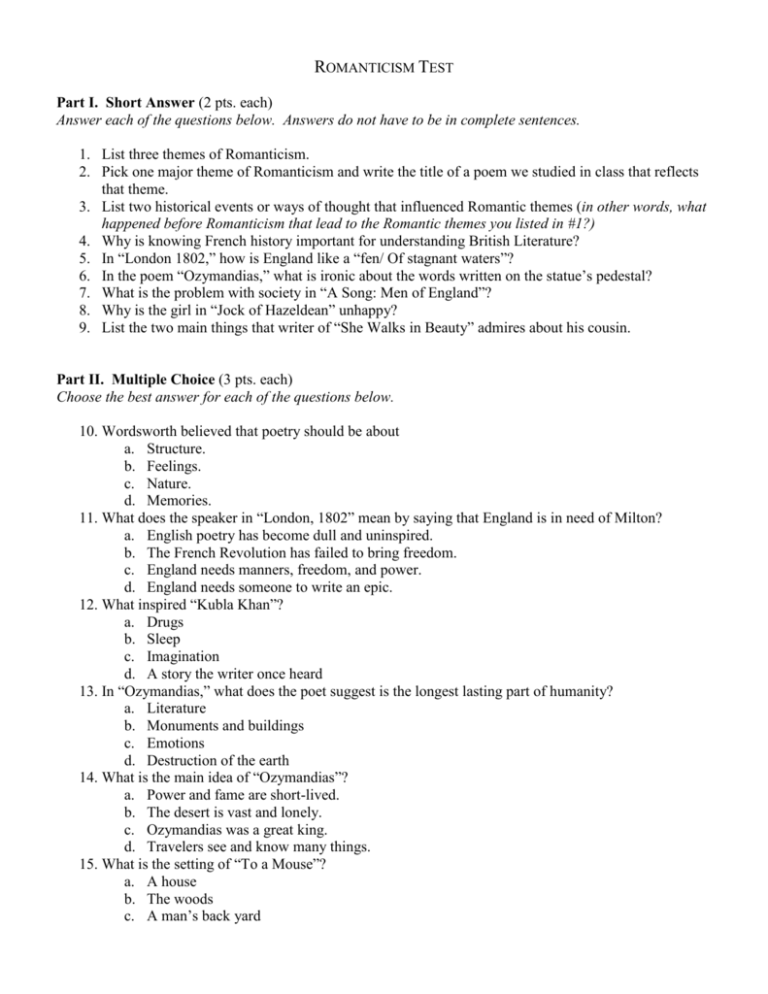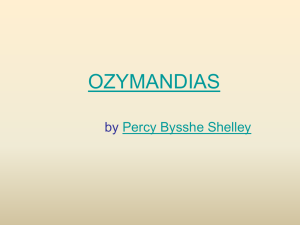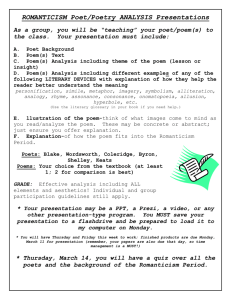test
advertisement

ROMANTICISM TEST Part I. Short Answer (2 pts. each) Answer each of the questions below. Answers do not have to be in complete sentences. 1. List three themes of Romanticism. 2. Pick one major theme of Romanticism and write the title of a poem we studied in class that reflects that theme. 3. List two historical events or ways of thought that influenced Romantic themes (in other words, what happened before Romanticism that lead to the Romantic themes you listed in #1?) 4. Why is knowing French history important for understanding British Literature? 5. In “London 1802,” how is England like a “fen/ Of stagnant waters”? 6. In the poem “Ozymandias,” what is ironic about the words written on the statue’s pedestal? 7. What is the problem with society in “A Song: Men of England”? 8. Why is the girl in “Jock of Hazeldean” unhappy? 9. List the two main things that writer of “She Walks in Beauty” admires about his cousin. Part II. Multiple Choice (3 pts. each) Choose the best answer for each of the questions below. 10. Wordsworth believed that poetry should be about a. Structure. b. Feelings. c. Nature. d. Memories. 11. What does the speaker in “London, 1802” mean by saying that England is in need of Milton? a. English poetry has become dull and uninspired. b. The French Revolution has failed to bring freedom. c. England needs manners, freedom, and power. d. England needs someone to write an epic. 12. What inspired “Kubla Khan”? a. Drugs b. Sleep c. Imagination d. A story the writer once heard 13. In “Ozymandias,” what does the poet suggest is the longest lasting part of humanity? a. Literature b. Monuments and buildings c. Emotions d. Destruction of the earth 14. What is the main idea of “Ozymandias”? a. Power and fame are short-lived. b. The desert is vast and lonely. c. Ozymandias was a great king. d. Travelers see and know many things. 15. What is the setting of “To a Mouse”? a. A house b. The woods c. A man’s back yard d. A farm 16. At the end of “To a Mouse,” who does the poet feel has the advantage? a. Humans b. Mice c. Neither mice nor humans d. He is unsure 17. The writer of “The World is Too Much With Us” feels that man’s connection with nature is a. Broken. b. Unimportant. c. Strong . d. In the process of healing. 18. The poem “When I Have Fears That I May Cease to Be” suggests that a. Death is an extension of life. b. You shouldn’t fear death if you have lived a good life. c. Death is a terrifying prospect. d. There is no afterlife. 19. Which is the best paraphrase of these lines from “When I Have Fears That I May Cease to Be?” When I have fears that I may cease to be Before my pen has gleaned my teeming brain, a. I am afraid that I will die before I have been able to write everything I want. b. I am afraid that I will die before I have learned to be a skilled writer. c. I am afraid that my brain has too many ideas to ever put down on paper. d. I am afraid that I do not have the skill to create great art. 20. What is the relationship between men and women in “Jock of Hazeldean”? a. Men have total control over women; women have no freedom. b. Men and women are equals. c. Women have some freedom, but there are consequences if they go against men’s wishes. d. Women are the dominant force, and men have to submit. 21. “So We’ll Go No More A’roving” is a poem about a. Finding love. b. Breaking up. c. Wandering around. d. Sleeping. 22. According to the writer of “A Vindication on the Rights of Woman,” men are overly concerned with a. Women’s appearance, not their education. b. Women’s submission, not their ability to lead. c. Women’s personality, not their character. d. Women’s flaws, not their potential. 23. “The Lamb” is a perfect example of a poem about a. Doubt. b. Love. c. Innocence. d. Experience. 24. “The Tyger” includes many a. Unanswered questions. b. Similes. c. References to the Bible. d. Different animals. 25. Why is little Tom Dacre crying in “The Chimney Sweeper”? a. His mother abandoned him. b. He was sold to a chimney sweep. c. He broke his arm while sweeping. d. His head was shaved. 26. Both “The Chimney Sweeper” and “Infant Sorrow” are written about young children. These children reflect a. Innocence. b. Experience. c. Both innocence and experience. d. Neither innocence nor experience. 27. “The best laid schemes o’ mice an’ men” is a famous line from the poem a. “Kubla Khan.” b. “The World is Too Much With Us.” c. “To a Mouse.” d. “The Lamb.” 28. In what poem are the lines “And all that’s best of dark and bright/ Meet in her aspect and her eyes”? a. “So We’ll Go No More A’Roving” b. “She Walks in Beauty” c. “The Tyger” d. “Jock of Hazeldean” 29. “It was a miracle of rare device,/ A sunny pleasure dome with caves of ice.” This quote is from the poem a. “Ozymandias.” b. “The Chimney Sweeper.” c. “So We’ll Go No More A-Roving.” d. “Kubla Khan.” Part III. TP-CASTT (10 points) Use the TP-CASTT method to analyze the poem below. Note: TP-CASTT stands for: Title (initial impression), Paraphrase, Connotation (poetic elements + how they impact tone and effect), Attitude, Shifts, Theme, Title (impression of title after having read the poem). “Dover Beach” By Matthew Arnold The sea is calm to-night, The tide is full, the moon lies fair Upon the straits; -- on the French coast the light Gleams and is gone; the cliffs of England stand, Glimmering and vast, out in the tranquil bay. Come to the window, sweet is the night-air! Only, from the long line of spray Where the sea meets the moon-blanch'd land, Listen! you hear the grating roar Of pebbles which the waves draw back, and fling, At their return, up the high strand, Begin, and cease, and then again begin, With tremulous cadence slow, and bring The eternal note of sadness in. Sophocles long ago Heard it on the Aegean, and it brought Into his mind the turbid ebb and flow Of human misery; we Find also in the sound a thought, Hearing it by this distant northern sea. The sea of faith Was once, too, at the full, and round earth's shore Lay like the folds of a bright girdle furl'd. But now I only hear Its melancholy, long, withdrawing roar, Retreating, to the breath Of the night-wind, down the vast edges drear And naked shingles of the world. Ah, love, let us be true To one another! for the world which seems To lie before us like a land of dreams, So various, so beautiful, so new, Hath really neither joy, nor love, nor light, Nor certitude, nor peace, nor help for pain; And we are here as on a darkling plain Swept with confused alarms of struggle and flight, Where ignorant armies clash by night. Part IV. Short essay (15 points) In one to two well-written paragraphs, answer the following prompt. Having read several poems and part of an essay from the Romantic era, how would you describe men and women and their relationships with one another during the time period of Romanticism? Be specific and make reference to specific texts when appropriate. Extra Credit For each of the following poems, write the author’s name. 1. “London 1802” __________________________________________________________________ 2. “Kubla Khan” ___________________________________________________________________ 3. “Ozymandias” ___________________________________________________________________ 4. “A Song: Men of England” _________________________________________________________ 5. “To a Mouse” ____________________________________________________________________ 6. “The World is Too Much With Us” ___________________________________________________ 7. “When I Have Fears That I May Cease to Be” ___________________________________________ 8. “Jock of Hazeldean” _______________________________________________________________ 9. “So, We’ll Go No More A’roving” ____________________________________________________ 10. “She Walks in Beauty” _____________________________________________________________ 11. “A Vindication of the Rights of Woman” _______________________________________________ 12. “The Lamb” ______________________________________________________________________ 13. “The Chimney Sweeper” ____________________________________________________________








